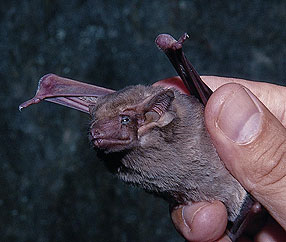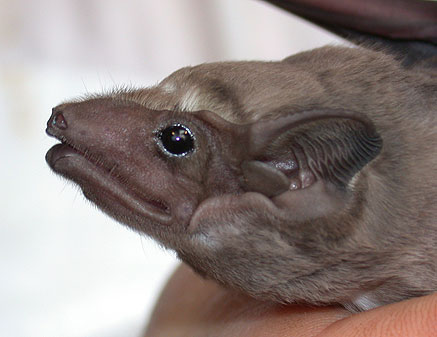Taphozous melanopogon
Black-bearded Tomb Bat; Black-bearded Sheathtail-bat
Morphological description Life history Distribution Habitat Roost sites and roosting patterns Emergence and flight pattern Foraging behaviour Echolocation calls Status and protection

Morphological Description
· Dorsal fur is russet brown to nearly black. Ventral fur is grey or paler.
· Average forearm length 64.6 mm (range 60.0-68.0mm) (Bates & Harrison, 1997). The bats we caught in Guangdong and Guangxi had forearm lengths between 65.6-67.1 mm.
· Generally, the black beard will appear at the age of approximately 6 months.
· Weights of bats in China were 24.3-29.2 g (n = 3). .
Life history
· Young are 7-8 g at birth, and gestation is 120-125 days (in Bates & Harrison 1997).
Distribution
Widespread: found from Sri Lanka and India to southern China, Java, Borneo and Philippines (Bates & Harrison 1997). The Chinese distribution is shown by dots on the map (as given by Zhang et al. (1997)).

Habitat
· Bates and Harrison (1997) noted that on India this species lives in hill forests, with fresh water such as a lake, river or pond in the vicinity, at an altitude of 800 metres.
Roost sites and roosting behaviour
· Found in caves in Guangxi and Guangdong, sometimes in large numbers. Roosts containing up to 15000 bats have been found in India (in Bates & Harrison 1997). Also roosts in temples, ruins and other old buildings in India. Often shares roosts with other species.
· The colony consists of males and females separately, or spatially segregated within the same colony (quoted from Bates & Harrison, 1997).
Emergence and flight pattern
· Narrow wings and a high wing loading and aspect ratio mean that this species flies rapidly and is not very manoeuvrable.
Foraging behaviour
· Nothing known.
Echolocation calls
. Bats emit long duration, multiharmonic calls with little change in bandwidth within each harmonic. The spectrogram below is from Indian bats recorded by Habersetzer (1986).

Status and protection
· There is no estimation of population size for China.
· Black-bearded tomb bats are widespread and probably not endangered on a global scale. Listed at LR/lc, assessed by the Red List of Threatened Species (IUCN, 2006) and are not protected by the Law of the People's Republic of China on the Protection of Wildlife in 1989.
· Caves and old buildings should be protected as their habitats.
